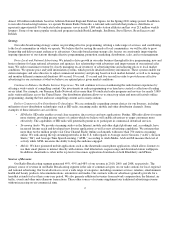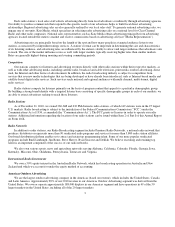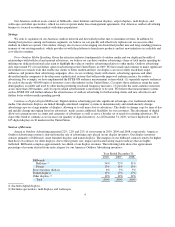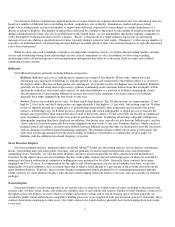iHeartMedia 2010 Annual Report Download - page 15
Download and view the complete annual report
Please find page 15 of the 2010 iHeartMedia annual report below. You can navigate through the pages in the report by either clicking on the pages listed below, or by using the keyword search tool below to find specific information within the annual report.
Local governments generally also include billboard control as part of their zoning laws and building codes regulating those items
described above and include similar provisions regarding the removal of non-grandfathered structures that do not comply with certain
of the local requirements. Some local governments have initiated code enforcement and permit reviews of billboards within their
j
urisdiction challenging billboards located within their jurisdiction, and in some instances we have had to remove billboards as a
result of such reviews.
As part of their billboard control laws, state and local governments regulate the construction of new signs. Some jurisdictions
prohibit new construction, some jurisdictions allow new construction only to replace existing structures and some jurisdictions allow
new construction subject to the various restrictions discussed above. In certain jurisdictions, restrictive regulations also limit our
ability to relocate, rebuild, repair, maintain, upgrade, modify or replace existing legal non-conforming billboards. While these
regulations set certain limits on the construction of new outdoor advertising displays, they also benefit established companies,
including us, by creating barriers to entry and by protecting the outdoor advertising industry against an oversupply of inventory.
Federal law neither requires nor prohibits the removal of existing lawful billboards, but it does mandate the payment of
compensation if a state or political subdivision compels the removal of a lawful billboard along the controlled roads. In the past, state
governments have purchased and removed existing lawful billboards for beautification purposes using Federal funding for
transportation enhancement programs, and these jurisdictions may continue to do so in the future. From time to time, state and local
government authorities use the power of eminent domain and amortization to remove billboards. Thus far, we have been able to
obtain satisfactory compensation for our billboards purchased or removed as a result of these types of governmental action, although
there is no assurance that this will continue to be the case in the future.
Other important outdoor advertising regulations include the Intermodal Surface Transportation Efficiency Act of 1991 (currently
known as “SAFETEA-LU”), the Bonus Act/Bonus Program, the 1995 Scenic Byways Amendment and various increases or
implementations of property taxes, billboard taxes and permit fees.
From time to time, legislation has been introduced in both the United States and foreign jurisdictions attempting to impose taxes
on revenue from outdoor advertising. Several state and local jurisdictions have already imposed such taxes as a percentage of our
outdoor advertising revenue in that jurisdiction. While these taxes have not had a material impact on our business and financial results
to date, we expect state and local governments to continue to try to impose such taxes as a way of increasing revenue.
We have introduced and intend to expand the deployment of digital billboards that display static digital advertising copy from
various advertisers that change up to several times per minute. We have encountered some existing regulations that restrict or prohibit
these types of digital displays. However, since digital technology for changing static copy has only recently been developed and
introduced into the market on a large scale, existing regulations that currently do not apply to digital technology by their terms could
be revised to impose greater restrictions. These regulations may impose greater restrictions on digital billboards due to alleged
concerns over aesthetics or driver safety.
International regulations have a significant impact on the outdoor advertising industry and our business. International regulation
of the outdoor advertising industry can vary by municipality, region and country but generally limits the size, placement, nature and
density of out-of-home displays. Other regulations may limit the subject matter and language of out-of-home displays.
ITEM 1A. Risk Factors
Risks Related to Our Business
Our results have been in the past, and could be in the future, adversely affected by deteriorations in economic conditions
The risks associated with our businesses become more acute in periods of a slowing economy or recession, which may be
accompanied by a decrease in advertising. Expenditures by advertisers tend to be cyclical, reflecting economic conditions and
budgeting and buying patterns. The recent global economic downturn resulted in a decline in advertising and marketing by our
customers, which resulted in a decline in advertising revenues across our businesses. This reduction in advertising revenues had an
adverse effect on our revenue, profit margins, cash flow and liquidity. Although we believe that global economic conditions are
improving, if they do not continue to improve or if they deteriorate again, global economic conditions may once again adversely
impact our revenue, profit margins, cash flow and liquidity. Furthermore, because a significant portion of our revenue is derived from
local advertisers, our ability to
12
























